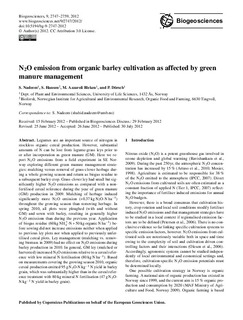| dc.contributor.author | Nadeem, Shahid | |
| dc.contributor.author | Hansen, Sissel | |
| dc.contributor.author | Bleken, Marina Azzaroli | |
| dc.contributor.author | Dörsch, Peter | |
| dc.date.accessioned | 2017-10-11T13:49:05Z | |
| dc.date.available | 2017-10-11T13:49:05Z | |
| dc.date.created | 2012-10-23T15:02:00Z | |
| dc.date.issued | 2012 | |
| dc.identifier.citation | Nadeem, S., Hansen, S., Bleken, M. A., & Dörsch, P. (2012). N2O emission from organic barley cultivation as affected by green manure management. Biogeosciences, 9(7), 2747. | nb_NO |
| dc.identifier.issn | 1726-4170 | |
| dc.identifier.uri | http://hdl.handle.net/11250/2459753 | |
| dc.description.abstract | Legumes are an important source of nitrogen in stockless organic cereal production. However, substantial amounts of N can be lost from legume-grass leys prior to or after incorporation as green manure (GM). Here we report N2O emissions from a field experiment in SE Norway exploring different green manure management strategies: mulching versus removal of grass-clover herbage during a whole growing season and return as biogas residue to a subsequent barley crop. Grass-clover ley had small but significantly higher N2O emissions as compared with a non-fertilised cereal reference during the year of green manure (GM) production in 2009. Mulching of herbage induced significantly more N2O emission (+0.37 kg N2O-N ha−1) throughout the growing season than removing herbage. In spring 2010, all plots were ploughed (with and without GM) and sown with barley, resulting in generally higher N2O emissions than during the previous year. Application of biogas residue (60 kg NH4+-N + 50 kg organic N ha−1) before sowing did not increase emissions neither when applied to previous ley plots nor when applied to previously unfertilised cereal plots. Ley management (mulching vs. removing biomass in 2009) had no effect on N2O emissions during barley production in 2010. In general, GM ley (mulched or harvested) increased N2O emissions relative to a cereal reference with low mineral N fertilisation (80 kg N ha−1). Based on measurements covering the growing season 2010, organic cereal production emitted 95 g N2O-N kg−1 N yield in barley grain, which was substantially higher than in the cereal reference treatment with 80 kg mineral N fertilisation (47 g N2O-N kg−1 N yield in barley grain). | nb_NO |
| dc.language.iso | eng | nb_NO |
| dc.rights | Navngivelse 4.0 Internasjonal | * |
| dc.rights.uri | http://creativecommons.org/licenses/by/4.0/deed.no | * |
| dc.title | N2O emission from organic barley cultivation as affected by green manure management | nb_NO |
| dc.type | Journal article | nb_NO |
| dc.type | Peer reviewed | nb_NO |
| dc.description.version | publishedVersion | nb_NO |
| dc.rights.holder | © Author(s) 2012. This work is distributed under the Creative Commons Attribution 3.0 License. | nb_NO |
| dc.source.pagenumber | 2747-2759 | nb_NO |
| dc.source.volume | 9 | nb_NO |
| dc.source.journal | Biogeosciences | nb_NO |
| dc.source.issue | 7 | nb_NO |
| dc.identifier.doi | 10.5194/bg-9-2747-2012 | |
| dc.identifier.cristin | 952231 | |
| dc.relation.project | Norges forskningsråd: 193613 | nb_NO |
| dc.relation.project | Norges forskningsråd: 184970 | nb_NO |
| cristin.ispublished | true | |
| cristin.fulltext | original | |
| cristin.qualitycode | 1 | |

